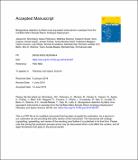Biosignature detection by Mars rover equivalent instruments in samples from the CanMars Mars Sample Return Analogue Deployment
Abstract
This work details the laboratory analysis of a suite of 10 samples collected from an inverted fluvial channel near Hanksville, Utah, USA as a part of the CanMars Mars Sample Return Analogue Deployment (MSRAD). The samples were acquired along the rover traverse for detailed off-site analysis to evaluate the TOC and astrobiological significance of the samples selected based on site observations, and to address one of the science goals of the CanMars mission: to evaluate the ability of different analytical techniques being employed by the Mars2020 mission to detect and characterize any present biosignatures. Analytical techniques analogous to those on the ExoMars, MSL and the MER rovers were also applied to the samples. The total organic carbon content of the samples was <0.02% for all but 4 samples, and organic biosignatures were detected in multiple samples by UV–Vis–NIR reflectance spectroscopy and Raman spectroscopy (532 nm, time-resolved, and UV), which was the most effective of the techniques. The total carbon content of the samples is < 0.3 wt% for all but one calcite rich sample, and organic C was not detectable by FTIR. Carotene and chlorophyll were detected in two samples which also contained gypsum and mineral phases of astrobiological importance for paleoenvironment/habitability and biomarker preservation (clays, gypsum, calcite) were detected and characterized by multiple techniques, of which passive reflectance was most effective. The sample selected in the field (S2) as having the highest potential for TOC did not have the highest TOC values, however, when considering the sample mineralogy in conjunction with the detection of organic carbon, it is the most astrobiologically relevant. These results highlight importance of applying multiple techniques for sample characterization and provide insights into their strengths and limitations.
Citation
Stromberg , J M , Parkinson , A , Morison , M , Cloutis , E , Casson , N , Applin , D , Poitras , J , Marti , A M , Maggiori , C , Cousins , C , Whyte , L , Kruzelecky , R , Das , D , Leveille , R , Berlo , K , Sharma , S K , Acosta-Maeda , T , Daly , M & Lalla , E 2019 , ' Biosignature detection by Mars rover equivalent instruments in samples from the CanMars Mars Sample Return Analogue Deployment ' , Planetary and Space Science , vol. 176 , 104683 . https://doi.org/10.1016/j.pss.2019.06.007
Publication
Planetary and Space Science
Status
Peer reviewed
ISSN
0032-0633Type
Journal article
Description
The University of Winnipeg's HOSERLab was established with funding from the Canada Foundation for Innovation, the Manitoba Research Innovations Fund and the Canadian Space Agency, whose support is gratefully acknowledged. This study was supported with grants from the Canadian Space Agency through their FAST program, NSERC, and UWinnipeg.Collections
Items in the St Andrews Research Repository are protected by copyright, with all rights reserved, unless otherwise indicated.

